QAMYAB – THE FORGOTTEN GEMS OF BOLLYWOOD
Qamyab is our humble tribute to all those lesser-known actors, one hit wonders and junior artists who we see umpteen times but don’t know about; beyond their faces. These actors have been an integral part of Bollywood but didn’t get their due. This series is our sincere attempt to put a name to these faces, familiarize them to our readers and celebrate their achievements in life – however big or small. We believe that every artist contributes in his/her own way to the cinema’s success. Qamyab will explore the unknown lives of such actors and artists as we believe even these forgotten gems of Bollywood deserve their due recognition today.
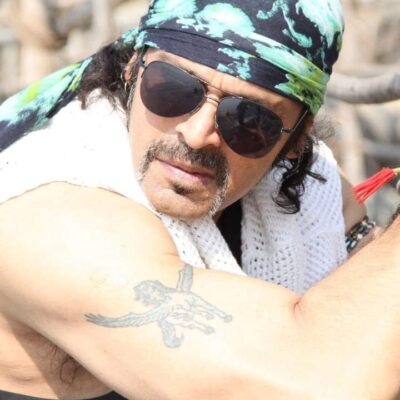
We are 50 already!!
Yes, dear readers, the Qamyab series celebrates its 50th golden article with one of the most handsome and dashing actors of Bollywood, who made his mark in negative roles. He is Mahesh Anand.
The early ’80s Bollywood saw emergence of many star kids like Sunny Deol, Kumar Gaurav, Sanjay Dutt, Karan Kapoor, Rajiv Kapoor, Kunal Goswami, Mohnish Behl and Suniel Anand to name a few. Apart from Sunny Deol and Sanjay Dutt, most of them fizzled out after two to three releases. A couple of ‘outsiders’ like Jackie Shroff and Mithun Chakraborty became big stars as well. Around this time, one more outsider called Mahesh Anand was trying to enter the big bad world of Bollywood. The tall, fair and handsome Mahesh was a trained dancer as well as a Karate blackbelt.
It may surprise you that Mahesh Anand had his roots in Hindi Cinema as his mother Tara Devi was an actress who acted in mythological films in ’40s and ’50s. Sadly, she passed away when Mahesh was just two years old and since then, his family didn’t have any connection with film industry. Mahesh had a macho personality as he used to work as a mechanic in his father’s garage before entering Bollywood. The garage was later taken over by his step siblings.
Mahesh’s first break came with Barkha Movies’ Sanam Teri Kasam (1982) produced by Barkha Roy, sister of famous actor Reena Roy, who became his future wife. Though Anand didn’t have a formal role in the movie, he was seen dancing as a silhouette in the opening credits. Sanam Teri Kasam became a box office hit and Barkha repeated the same dance sequence in her next Karishma (1984). This time, Mahesh got to dance with Kamal Haasan and also played a small yet pivotal role in that movie.
Later, the same dance sequence footage was used in credits of films like Tan Badan (1986), Woh Mili Thi (1988) and a south dubbed movie called Badle Ki Jwala (1986).
Next, Mahesh Anand was considered to play the lead role in B. Subhash’s Adventures of Tarzan (1985). However, he lost the role to Hemant Birje as Subhash wanted a new face for his titular character while Mahesh was already seen by the audience in Karishma and Bhavani Junction (1985).
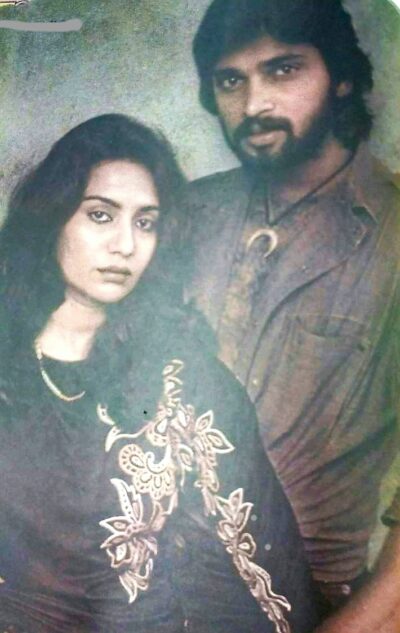
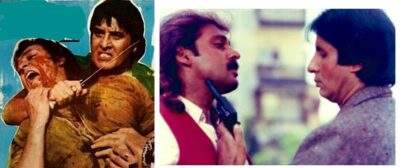
Finally in 1986, Mahesh Anand got to play the lead in Bhappi Sonie’s Sasti Dulhan Mahenga Dulha opposite Priya Tendulkar. Aditya Panscholi was the other hero of this movie. Unfortunately, the movie bombed badly and could not do anything for Mahesh Anand’s career as far as lead roles were concerned.
Mahesh always aspired to work with his two idols – Vinod Khanna and Amitabh Bachchan and his dream came true when he played the negative character of Michael Fernandes in Khanna’s comeback film Insaaf (1987). The film became an instant success and there was no looking back for him as negative roles started pouring in by the dozen. Soon enough, his dream to work with superstar Amitabh Bachchan also fructified with Shahenshah (1988) where he played a street goon who extorts money from the poor labourers in the title song “Andheri raaton mein’.
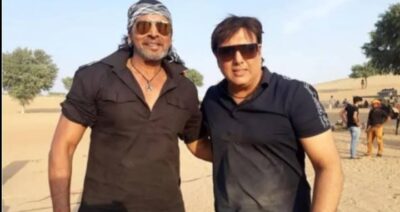
From the late ’80s until the turn of the millennium, the whole decade belonged to Mahesh Anand where he played a negative character in almost every Hindi film. Most of the time, he would either be a spoilt kid of the main villain or the villain’s henchman or a street thug on wrong side of the law. Some of his notable performances include Insaaf (1987), Shahenshah (1988), Kabzaa (1988), Gangaa Jamunaa Saraswathi (1988), Ilaaka (1989), Mujrim (1989), Toofan (1989), Aag Ka Gola (1989), Jurm (1990), Thanedaar (1990,) Akayla (1991), Trinetra (1991), Pratikaar (1991), Indrajeet (1991), Vishwatma (1992), Zulm Ki Hukumat (1992), Sir (1993), Waqt Hamara Hai (1993), Hum Hain Kamaal Ke (1993), Khuddar (1994), Krantiveer (1994), Coolie No 1 (1995), Vijeta (1996), Muqadama (1996) and Lal Baadshah (1999).
While he was the villain in all the aforementioned movies, his dancing skills were utilized in a few films like Bhavani Junction (1985), Dharam Shatru (1988), Vishwatma (1992), Game (1993), Gurudev (1993) and Waqt Hamara Hai (1993).
Not restricting himself to Bollywood, Mahesh Anand made a name for himself in South cinema as well and acted in several Tamil ,Malayalam and Telugu films. Some of his noteworthy Southern ventures are Lankeshwarudu (1989), Abhimanyu (1991), Bobbili Simham (1994), Auto Driver Veera (1994), The Godman (1999), etc. But of all these, he is best remembered for Sivasakthi (1991) which was remake of Amitabh Bachchan cult classic Agneepath (1990) where he played the main antagonist Marc Zuber Anthony which was modelled on lines of Danny Denzongpa’s Kancha Cheena.
The new millennium wasn’t kind to Mahesh Anand though he appeared in few films like Baaghi (2000), Kurukshetra (2000), Ek Aur Ek Gyaarah (2003) and the much-delayed Ssukh (2005). Actually, the trouble started around 2000 while shooting for a film with no proper safety measures, Anand met with a major accident and suffered a back injury which restricted him to bed for months and no work out for at least a year. He recuperated slowly but it took a toll on his physique. By the time he was fit and ready to resume work, Bollywood had undergone a transformation with the new plots offering no scope for the regular villains or henchmen like before.
In between all this, Mahesh managed to do a Balaji serial Ghar EK Mandir (2001) aired on Sony TV where he played a father of Sweta Kawatra. David Dhawan’s Ek Aur Ek Gyaarah (2003) was his last notable release where he didn’t play a negative role while the long delayed Ssukh finally made it to cinemas in 2005.
These were his last assignments after which there were no offers for the once busy actor. Mahesh Anand, who had always devoted his life towards acting, was completely forgotten by the upcoming generation and this led him to alcohol and depression. In the coming years, he was struggling hard to make the ends meet. He shifted from his plush bungalow to a one room kitchen in an old building in Versova, where he lived right till his end.
His personal life too wasn’t good after a couple of failed marriages with Barkha Roy, Erica Maria D’Souza, Madhu Malhotra and Usha Bachnani. Mahesh had a son named Trishul from Erica but some differences cropped up between the two and Erica left him taking toddler Trishul along with her, never to return. Even in his last days, Mahesh was living with the hope that someday he might get to meet his son. Sadly, that never happened.
Surprisingly, Mahesh Anand became active on social media (Facebook) around mid-2015 and his fans gave him a warm welcome. He was overwhelmed seeing the response. He had maintained his macho personality by keeping himself fit but was broken hearted within as he didn’t have work. Around the same time, he surprised everyone by marrying a Belarus bred foreigner named Lanna. Mahesh finally had something to cheer about.
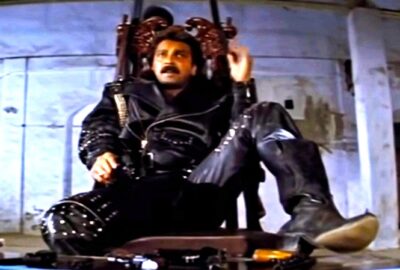
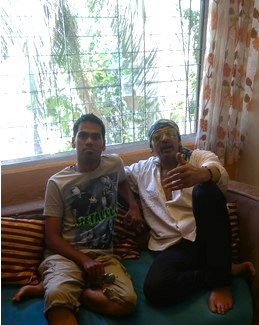
Our co-author Alex Almeida was in touch with him in those days and he used to call Alex one of his biggest fans. Soon, Alex introduced him to some of the film related groups on Facebook where he would regularly interact with his fans. But after a while, some cheeky fans asked him a few uncomfortable questions about his failed marriages which obviously didn’t go well with him and he left those groups but would individually chat with his fans.
Around 2016, rumours spread about Mahesh Anand- Lanna split but he quickly cleared the air by stating that she had shifted to Belarus due to visa issues. From 2017, he disappeared from social media as well. He called some of his well-wishers including Alex that he was suffering from cancer and needed money urgently.
Next day, Alex visited him at his Versova home and saw the six-feet tall and rugged Mahesh Anand was a pale shadow of himself. In those few hours spent with him, Mahesh reflected on his life and how he came in to the film industry and got to work with his icons Vinod Khanna and Amitabh Bachchan. He also lamented that there was no help extended to him from the very industry he worked for more than two decades.
Around late 2018, Alex got a call from Mahesh and he revealed to have signed a Pahlaj Nihalani film called Rangeela Raja starring Govinda where he would portray the villain in the climax (but later, Nihalani clarified that Mahesh had personally requested to cast him in that film). Mahesh was mighty excited about the role though it was just six minutes long as he believed this could be his potential comeback to Bollywood. He even asked Alex to be his secretary if his career clicks again.
Rangeela Raja released on 18th January 2019 and on 9th February 2019, Mahesh Anand was found dead in his apartment. His maid informed his sister when he didn’t respond for two days and upon opening the door to everyone’s horror, he was found dead sitting on a sofa with the television on and a food plate and an alcohol bottle on the table. The exact cause of his death was never disclosed but it is speculated that excessive drinking of rum had damaged his system. Lanna, who was stuck in Belarus since long, finally came to Mumbai and decided to perform his final rites with the family. It was indeed a sad ending for an actor, who had a noteworthy career as the villain in the ’80s and ’90s.
A parting note on Mahesh Anand with his ever-popular dialogue from Pratikaar (1991):
“Hum Roop Nagar Ke Cheeteh Hai. Shikaar Par Hi Jeete Hai”.
All images courtesy Internet
COMMENTS